Case Study Analysis of Alzheimer Disease
VerifiedAdded on 2022/09/06
|9
|2433
|21
AI Summary
Contribute Materials
Your contribution can guide someone’s learning journey. Share your
documents today.
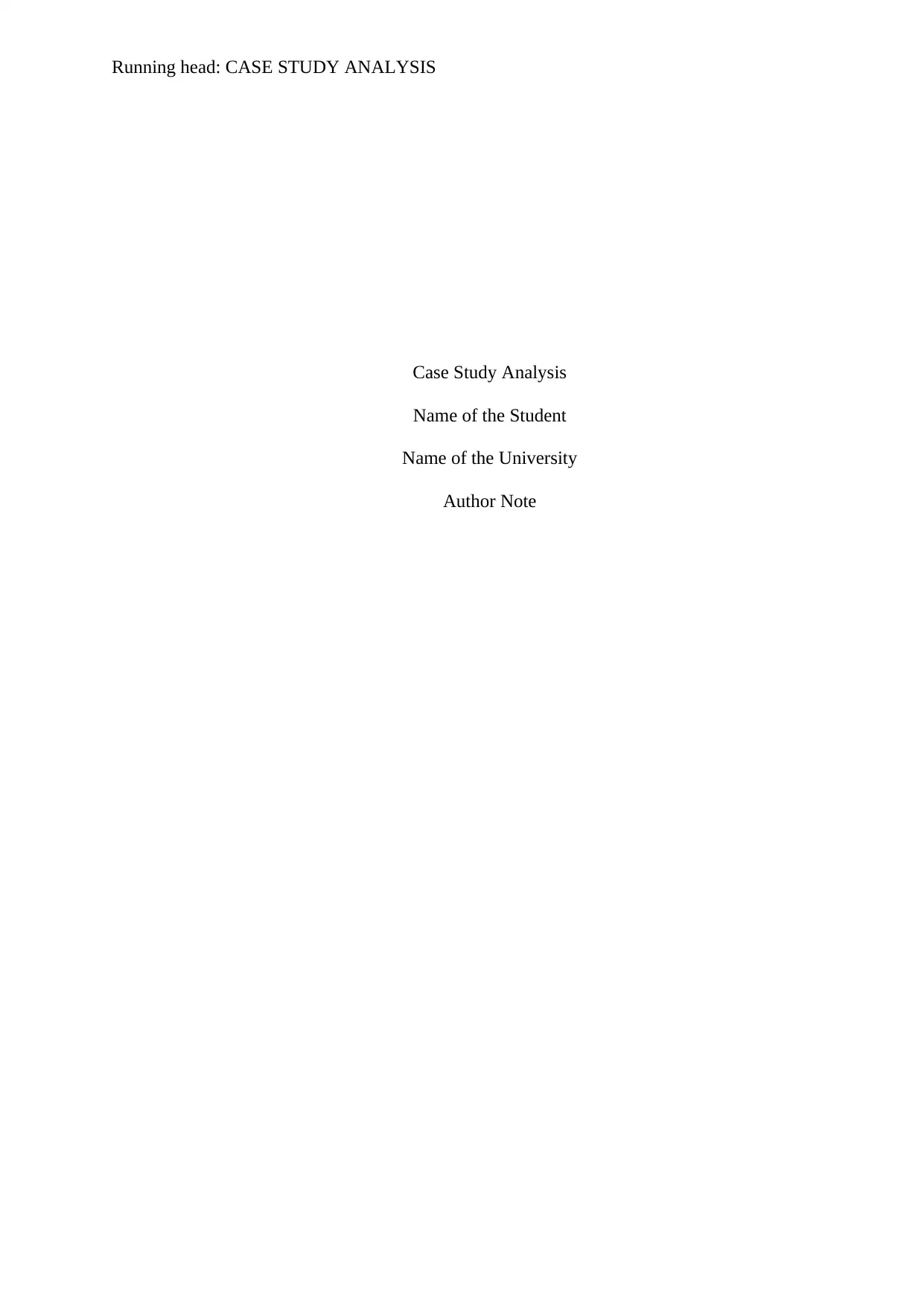
Running head: CASE STUDY ANALYSIS
Case Study Analysis
Name of the Student
Name of the University
Author Note
Case Study Analysis
Name of the Student
Name of the University
Author Note
Secure Best Marks with AI Grader
Need help grading? Try our AI Grader for instant feedback on your assignments.
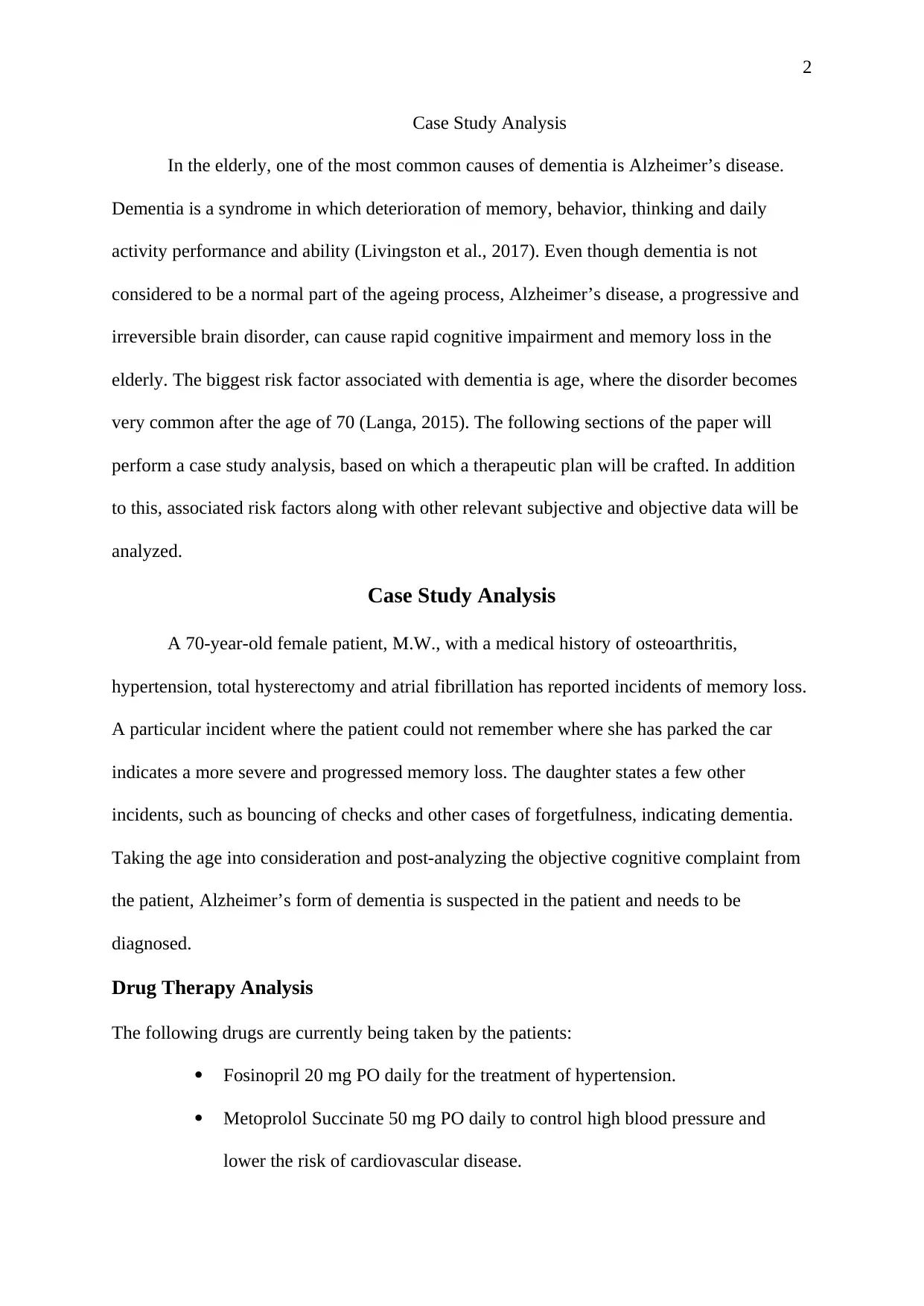
2
Case Study Analysis
In the elderly, one of the most common causes of dementia is Alzheimer’s disease.
Dementia is a syndrome in which deterioration of memory, behavior, thinking and daily
activity performance and ability (Livingston et al., 2017). Even though dementia is not
considered to be a normal part of the ageing process, Alzheimer’s disease, a progressive and
irreversible brain disorder, can cause rapid cognitive impairment and memory loss in the
elderly. The biggest risk factor associated with dementia is age, where the disorder becomes
very common after the age of 70 (Langa, 2015). The following sections of the paper will
perform a case study analysis, based on which a therapeutic plan will be crafted. In addition
to this, associated risk factors along with other relevant subjective and objective data will be
analyzed.
Case Study Analysis
A 70-year-old female patient, M.W., with a medical history of osteoarthritis,
hypertension, total hysterectomy and atrial fibrillation has reported incidents of memory loss.
A particular incident where the patient could not remember where she has parked the car
indicates a more severe and progressed memory loss. The daughter states a few other
incidents, such as bouncing of checks and other cases of forgetfulness, indicating dementia.
Taking the age into consideration and post-analyzing the objective cognitive complaint from
the patient, Alzheimer’s form of dementia is suspected in the patient and needs to be
diagnosed.
Drug Therapy Analysis
The following drugs are currently being taken by the patients:
Fosinopril 20 mg PO daily for the treatment of hypertension.
Metoprolol Succinate 50 mg PO daily to control high blood pressure and
lower the risk of cardiovascular disease.
Case Study Analysis
In the elderly, one of the most common causes of dementia is Alzheimer’s disease.
Dementia is a syndrome in which deterioration of memory, behavior, thinking and daily
activity performance and ability (Livingston et al., 2017). Even though dementia is not
considered to be a normal part of the ageing process, Alzheimer’s disease, a progressive and
irreversible brain disorder, can cause rapid cognitive impairment and memory loss in the
elderly. The biggest risk factor associated with dementia is age, where the disorder becomes
very common after the age of 70 (Langa, 2015). The following sections of the paper will
perform a case study analysis, based on which a therapeutic plan will be crafted. In addition
to this, associated risk factors along with other relevant subjective and objective data will be
analyzed.
Case Study Analysis
A 70-year-old female patient, M.W., with a medical history of osteoarthritis,
hypertension, total hysterectomy and atrial fibrillation has reported incidents of memory loss.
A particular incident where the patient could not remember where she has parked the car
indicates a more severe and progressed memory loss. The daughter states a few other
incidents, such as bouncing of checks and other cases of forgetfulness, indicating dementia.
Taking the age into consideration and post-analyzing the objective cognitive complaint from
the patient, Alzheimer’s form of dementia is suspected in the patient and needs to be
diagnosed.
Drug Therapy Analysis
The following drugs are currently being taken by the patients:
Fosinopril 20 mg PO daily for the treatment of hypertension.
Metoprolol Succinate 50 mg PO daily to control high blood pressure and
lower the risk of cardiovascular disease.
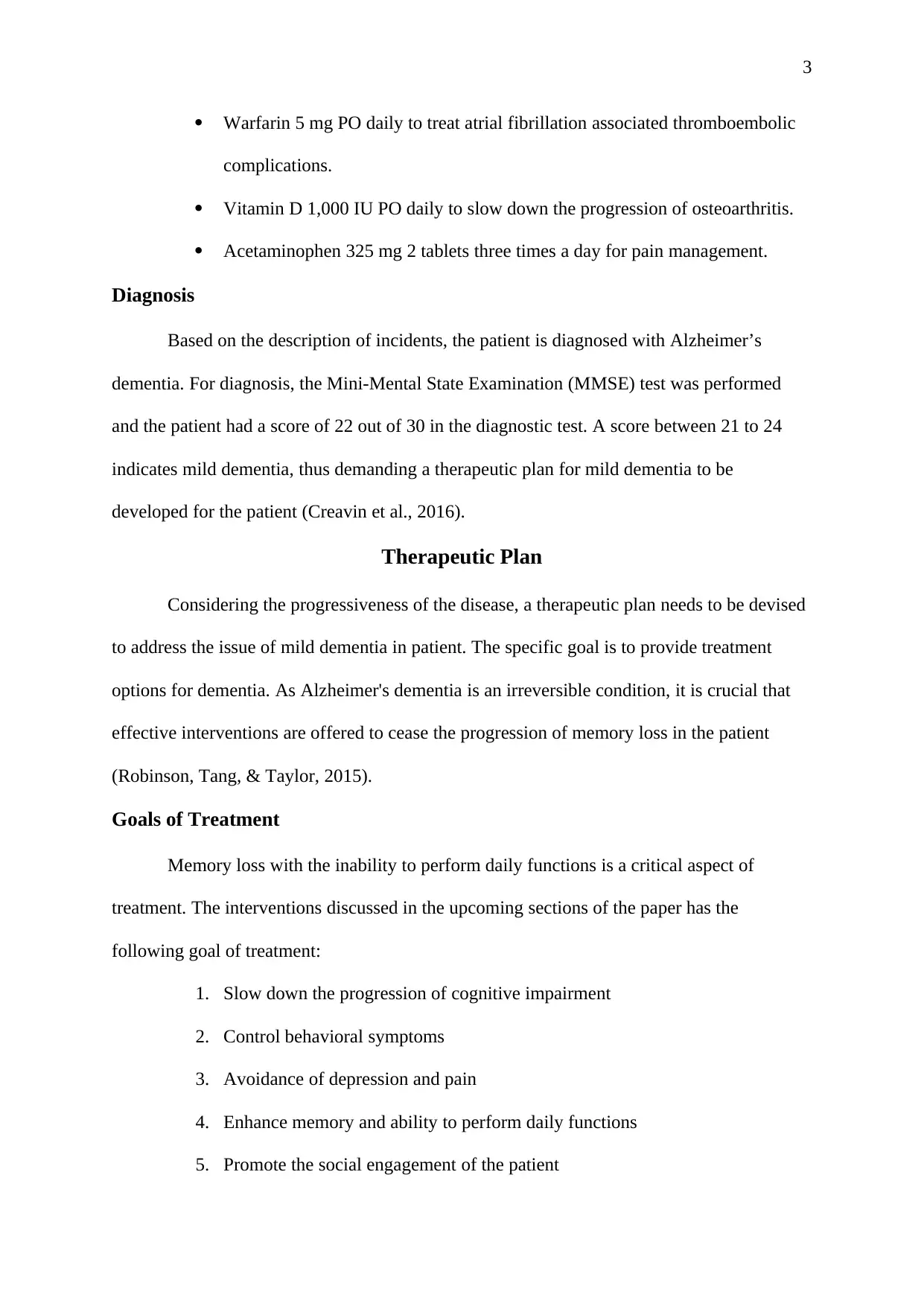
3
Warfarin 5 mg PO daily to treat atrial fibrillation associated thromboembolic
complications.
Vitamin D 1,000 IU PO daily to slow down the progression of osteoarthritis.
Acetaminophen 325 mg 2 tablets three times a day for pain management.
Diagnosis
Based on the description of incidents, the patient is diagnosed with Alzheimer’s
dementia. For diagnosis, the Mini-Mental State Examination (MMSE) test was performed
and the patient had a score of 22 out of 30 in the diagnostic test. A score between 21 to 24
indicates mild dementia, thus demanding a therapeutic plan for mild dementia to be
developed for the patient (Creavin et al., 2016).
Therapeutic Plan
Considering the progressiveness of the disease, a therapeutic plan needs to be devised
to address the issue of mild dementia in patient. The specific goal is to provide treatment
options for dementia. As Alzheimer's dementia is an irreversible condition, it is crucial that
effective interventions are offered to cease the progression of memory loss in the patient
(Robinson, Tang, & Taylor, 2015).
Goals of Treatment
Memory loss with the inability to perform daily functions is a critical aspect of
treatment. The interventions discussed in the upcoming sections of the paper has the
following goal of treatment:
1. Slow down the progression of cognitive impairment
2. Control behavioral symptoms
3. Avoidance of depression and pain
4. Enhance memory and ability to perform daily functions
5. Promote the social engagement of the patient
Warfarin 5 mg PO daily to treat atrial fibrillation associated thromboembolic
complications.
Vitamin D 1,000 IU PO daily to slow down the progression of osteoarthritis.
Acetaminophen 325 mg 2 tablets three times a day for pain management.
Diagnosis
Based on the description of incidents, the patient is diagnosed with Alzheimer’s
dementia. For diagnosis, the Mini-Mental State Examination (MMSE) test was performed
and the patient had a score of 22 out of 30 in the diagnostic test. A score between 21 to 24
indicates mild dementia, thus demanding a therapeutic plan for mild dementia to be
developed for the patient (Creavin et al., 2016).
Therapeutic Plan
Considering the progressiveness of the disease, a therapeutic plan needs to be devised
to address the issue of mild dementia in patient. The specific goal is to provide treatment
options for dementia. As Alzheimer's dementia is an irreversible condition, it is crucial that
effective interventions are offered to cease the progression of memory loss in the patient
(Robinson, Tang, & Taylor, 2015).
Goals of Treatment
Memory loss with the inability to perform daily functions is a critical aspect of
treatment. The interventions discussed in the upcoming sections of the paper has the
following goal of treatment:
1. Slow down the progression of cognitive impairment
2. Control behavioral symptoms
3. Avoidance of depression and pain
4. Enhance memory and ability to perform daily functions
5. Promote the social engagement of the patient
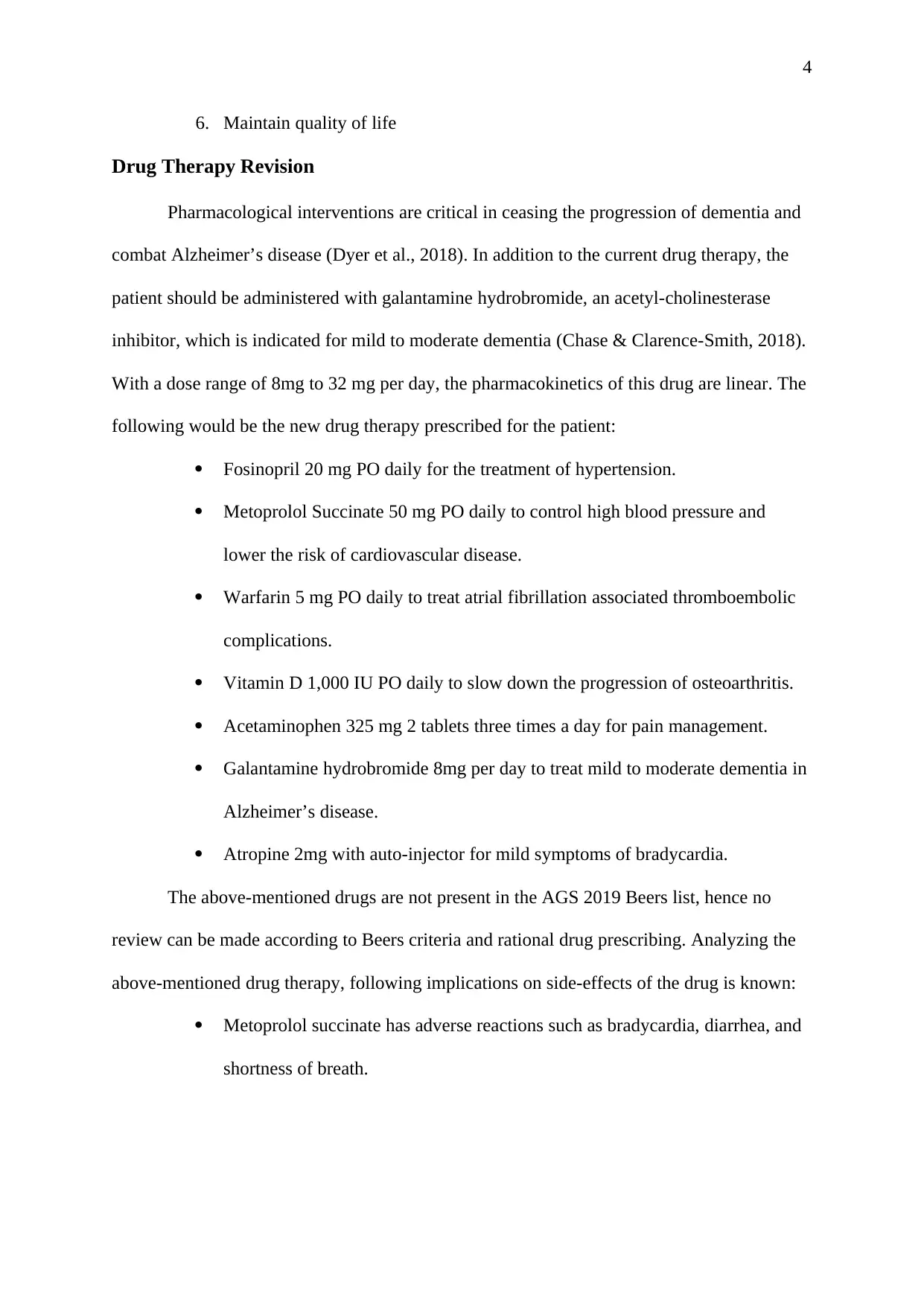
4
6. Maintain quality of life
Drug Therapy Revision
Pharmacological interventions are critical in ceasing the progression of dementia and
combat Alzheimer’s disease (Dyer et al., 2018). In addition to the current drug therapy, the
patient should be administered with galantamine hydrobromide, an acetyl-cholinesterase
inhibitor, which is indicated for mild to moderate dementia (Chase & Clarence-Smith, 2018).
With a dose range of 8mg to 32 mg per day, the pharmacokinetics of this drug are linear. The
following would be the new drug therapy prescribed for the patient:
Fosinopril 20 mg PO daily for the treatment of hypertension.
Metoprolol Succinate 50 mg PO daily to control high blood pressure and
lower the risk of cardiovascular disease.
Warfarin 5 mg PO daily to treat atrial fibrillation associated thromboembolic
complications.
Vitamin D 1,000 IU PO daily to slow down the progression of osteoarthritis.
Acetaminophen 325 mg 2 tablets three times a day for pain management.
Galantamine hydrobromide 8mg per day to treat mild to moderate dementia in
Alzheimer’s disease.
Atropine 2mg with auto-injector for mild symptoms of bradycardia.
The above-mentioned drugs are not present in the AGS 2019 Beers list, hence no
review can be made according to Beers criteria and rational drug prescribing. Analyzing the
above-mentioned drug therapy, following implications on side-effects of the drug is known:
Metoprolol succinate has adverse reactions such as bradycardia, diarrhea, and
shortness of breath.
6. Maintain quality of life
Drug Therapy Revision
Pharmacological interventions are critical in ceasing the progression of dementia and
combat Alzheimer’s disease (Dyer et al., 2018). In addition to the current drug therapy, the
patient should be administered with galantamine hydrobromide, an acetyl-cholinesterase
inhibitor, which is indicated for mild to moderate dementia (Chase & Clarence-Smith, 2018).
With a dose range of 8mg to 32 mg per day, the pharmacokinetics of this drug are linear. The
following would be the new drug therapy prescribed for the patient:
Fosinopril 20 mg PO daily for the treatment of hypertension.
Metoprolol Succinate 50 mg PO daily to control high blood pressure and
lower the risk of cardiovascular disease.
Warfarin 5 mg PO daily to treat atrial fibrillation associated thromboembolic
complications.
Vitamin D 1,000 IU PO daily to slow down the progression of osteoarthritis.
Acetaminophen 325 mg 2 tablets three times a day for pain management.
Galantamine hydrobromide 8mg per day to treat mild to moderate dementia in
Alzheimer’s disease.
Atropine 2mg with auto-injector for mild symptoms of bradycardia.
The above-mentioned drugs are not present in the AGS 2019 Beers list, hence no
review can be made according to Beers criteria and rational drug prescribing. Analyzing the
above-mentioned drug therapy, following implications on side-effects of the drug is known:
Metoprolol succinate has adverse reactions such as bradycardia, diarrhea, and
shortness of breath.
Secure Best Marks with AI Grader
Need help grading? Try our AI Grader for instant feedback on your assignments.
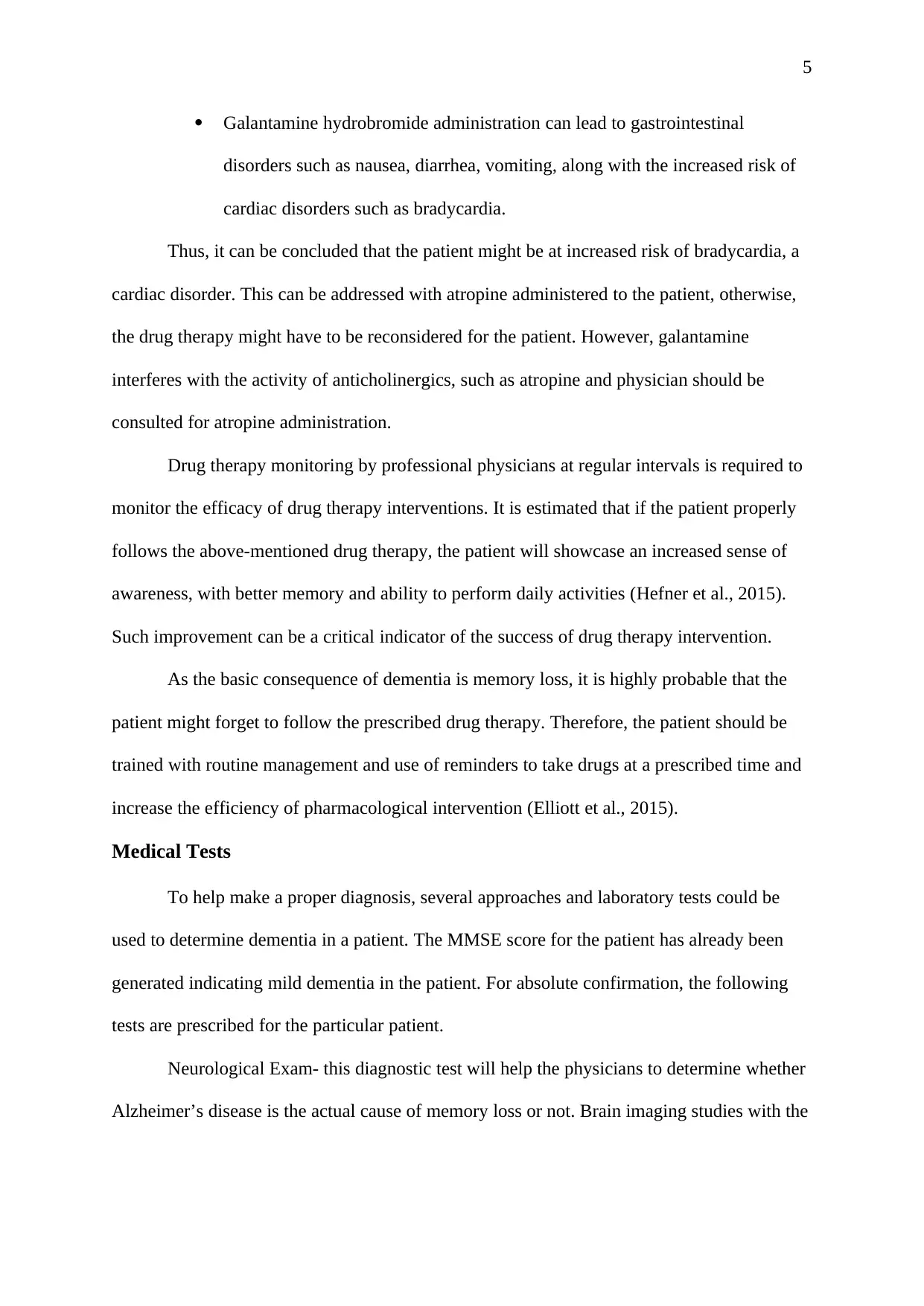
5
Galantamine hydrobromide administration can lead to gastrointestinal
disorders such as nausea, diarrhea, vomiting, along with the increased risk of
cardiac disorders such as bradycardia.
Thus, it can be concluded that the patient might be at increased risk of bradycardia, a
cardiac disorder. This can be addressed with atropine administered to the patient, otherwise,
the drug therapy might have to be reconsidered for the patient. However, galantamine
interferes with the activity of anticholinergics, such as atropine and physician should be
consulted for atropine administration.
Drug therapy monitoring by professional physicians at regular intervals is required to
monitor the efficacy of drug therapy interventions. It is estimated that if the patient properly
follows the above-mentioned drug therapy, the patient will showcase an increased sense of
awareness, with better memory and ability to perform daily activities (Hefner et al., 2015).
Such improvement can be a critical indicator of the success of drug therapy intervention.
As the basic consequence of dementia is memory loss, it is highly probable that the
patient might forget to follow the prescribed drug therapy. Therefore, the patient should be
trained with routine management and use of reminders to take drugs at a prescribed time and
increase the efficiency of pharmacological intervention (Elliott et al., 2015).
Medical Tests
To help make a proper diagnosis, several approaches and laboratory tests could be
used to determine dementia in a patient. The MMSE score for the patient has already been
generated indicating mild dementia in the patient. For absolute confirmation, the following
tests are prescribed for the particular patient.
Neurological Exam- this diagnostic test will help the physicians to determine whether
Alzheimer’s disease is the actual cause of memory loss or not. Brain imaging studies with the
Galantamine hydrobromide administration can lead to gastrointestinal
disorders such as nausea, diarrhea, vomiting, along with the increased risk of
cardiac disorders such as bradycardia.
Thus, it can be concluded that the patient might be at increased risk of bradycardia, a
cardiac disorder. This can be addressed with atropine administered to the patient, otherwise,
the drug therapy might have to be reconsidered for the patient. However, galantamine
interferes with the activity of anticholinergics, such as atropine and physician should be
consulted for atropine administration.
Drug therapy monitoring by professional physicians at regular intervals is required to
monitor the efficacy of drug therapy interventions. It is estimated that if the patient properly
follows the above-mentioned drug therapy, the patient will showcase an increased sense of
awareness, with better memory and ability to perform daily activities (Hefner et al., 2015).
Such improvement can be a critical indicator of the success of drug therapy intervention.
As the basic consequence of dementia is memory loss, it is highly probable that the
patient might forget to follow the prescribed drug therapy. Therefore, the patient should be
trained with routine management and use of reminders to take drugs at a prescribed time and
increase the efficiency of pharmacological intervention (Elliott et al., 2015).
Medical Tests
To help make a proper diagnosis, several approaches and laboratory tests could be
used to determine dementia in a patient. The MMSE score for the patient has already been
generated indicating mild dementia in the patient. For absolute confirmation, the following
tests are prescribed for the particular patient.
Neurological Exam- this diagnostic test will help the physicians to determine whether
Alzheimer’s disease is the actual cause of memory loss or not. Brain imaging studies with the
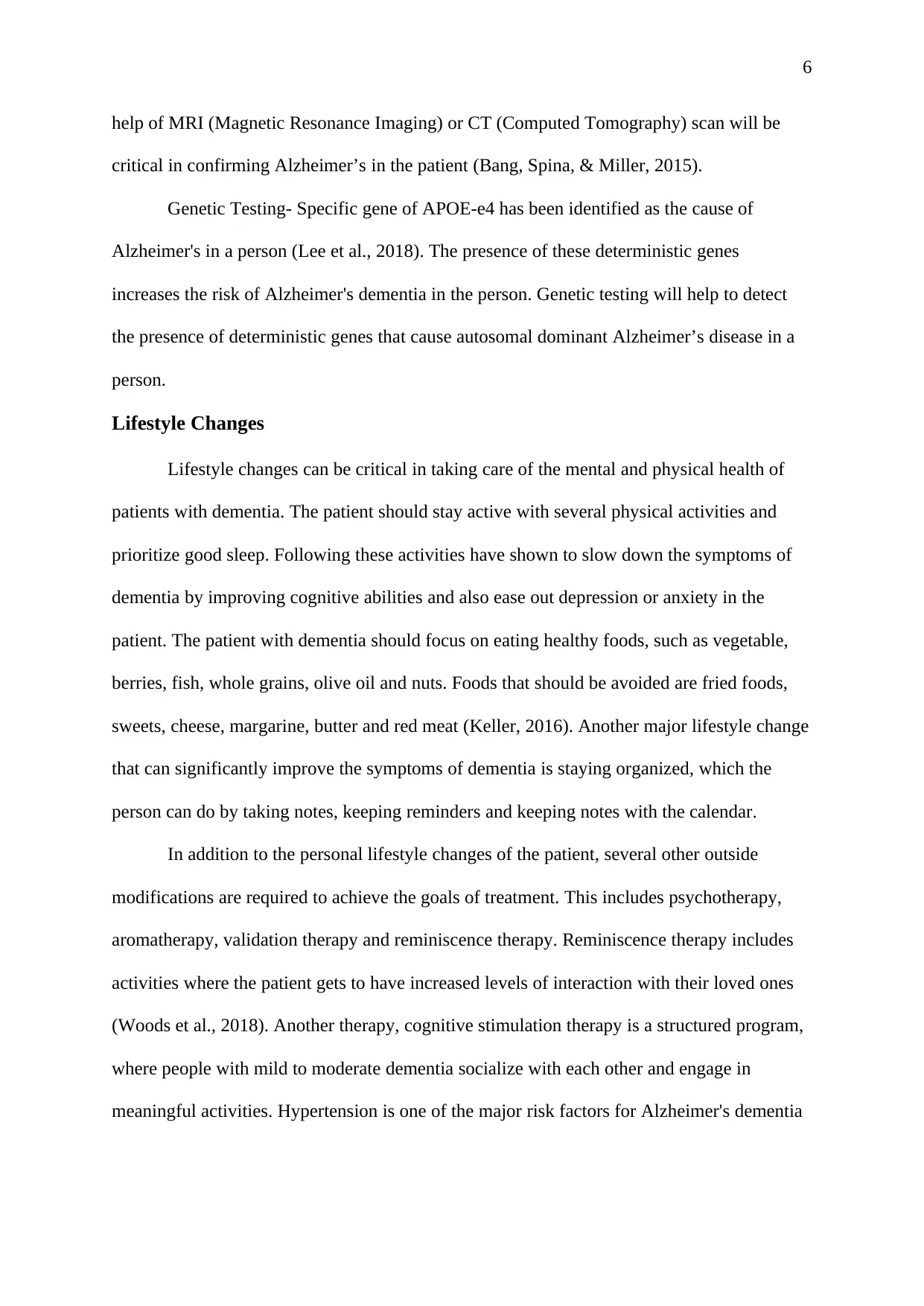
6
help of MRI (Magnetic Resonance Imaging) or CT (Computed Tomography) scan will be
critical in confirming Alzheimer’s in the patient (Bang, Spina, & Miller, 2015).
Genetic Testing- Specific gene of APOE-e4 has been identified as the cause of
Alzheimer's in a person (Lee et al., 2018). The presence of these deterministic genes
increases the risk of Alzheimer's dementia in the person. Genetic testing will help to detect
the presence of deterministic genes that cause autosomal dominant Alzheimer’s disease in a
person.
Lifestyle Changes
Lifestyle changes can be critical in taking care of the mental and physical health of
patients with dementia. The patient should stay active with several physical activities and
prioritize good sleep. Following these activities have shown to slow down the symptoms of
dementia by improving cognitive abilities and also ease out depression or anxiety in the
patient. The patient with dementia should focus on eating healthy foods, such as vegetable,
berries, fish, whole grains, olive oil and nuts. Foods that should be avoided are fried foods,
sweets, cheese, margarine, butter and red meat (Keller, 2016). Another major lifestyle change
that can significantly improve the symptoms of dementia is staying organized, which the
person can do by taking notes, keeping reminders and keeping notes with the calendar.
In addition to the personal lifestyle changes of the patient, several other outside
modifications are required to achieve the goals of treatment. This includes psychotherapy,
aromatherapy, validation therapy and reminiscence therapy. Reminiscence therapy includes
activities where the patient gets to have increased levels of interaction with their loved ones
(Woods et al., 2018). Another therapy, cognitive stimulation therapy is a structured program,
where people with mild to moderate dementia socialize with each other and engage in
meaningful activities. Hypertension is one of the major risk factors for Alzheimer's dementia
help of MRI (Magnetic Resonance Imaging) or CT (Computed Tomography) scan will be
critical in confirming Alzheimer’s in the patient (Bang, Spina, & Miller, 2015).
Genetic Testing- Specific gene of APOE-e4 has been identified as the cause of
Alzheimer's in a person (Lee et al., 2018). The presence of these deterministic genes
increases the risk of Alzheimer's dementia in the person. Genetic testing will help to detect
the presence of deterministic genes that cause autosomal dominant Alzheimer’s disease in a
person.
Lifestyle Changes
Lifestyle changes can be critical in taking care of the mental and physical health of
patients with dementia. The patient should stay active with several physical activities and
prioritize good sleep. Following these activities have shown to slow down the symptoms of
dementia by improving cognitive abilities and also ease out depression or anxiety in the
patient. The patient with dementia should focus on eating healthy foods, such as vegetable,
berries, fish, whole grains, olive oil and nuts. Foods that should be avoided are fried foods,
sweets, cheese, margarine, butter and red meat (Keller, 2016). Another major lifestyle change
that can significantly improve the symptoms of dementia is staying organized, which the
person can do by taking notes, keeping reminders and keeping notes with the calendar.
In addition to the personal lifestyle changes of the patient, several other outside
modifications are required to achieve the goals of treatment. This includes psychotherapy,
aromatherapy, validation therapy and reminiscence therapy. Reminiscence therapy includes
activities where the patient gets to have increased levels of interaction with their loved ones
(Woods et al., 2018). Another therapy, cognitive stimulation therapy is a structured program,
where people with mild to moderate dementia socialize with each other and engage in
meaningful activities. Hypertension is one of the major risk factors for Alzheimer's dementia
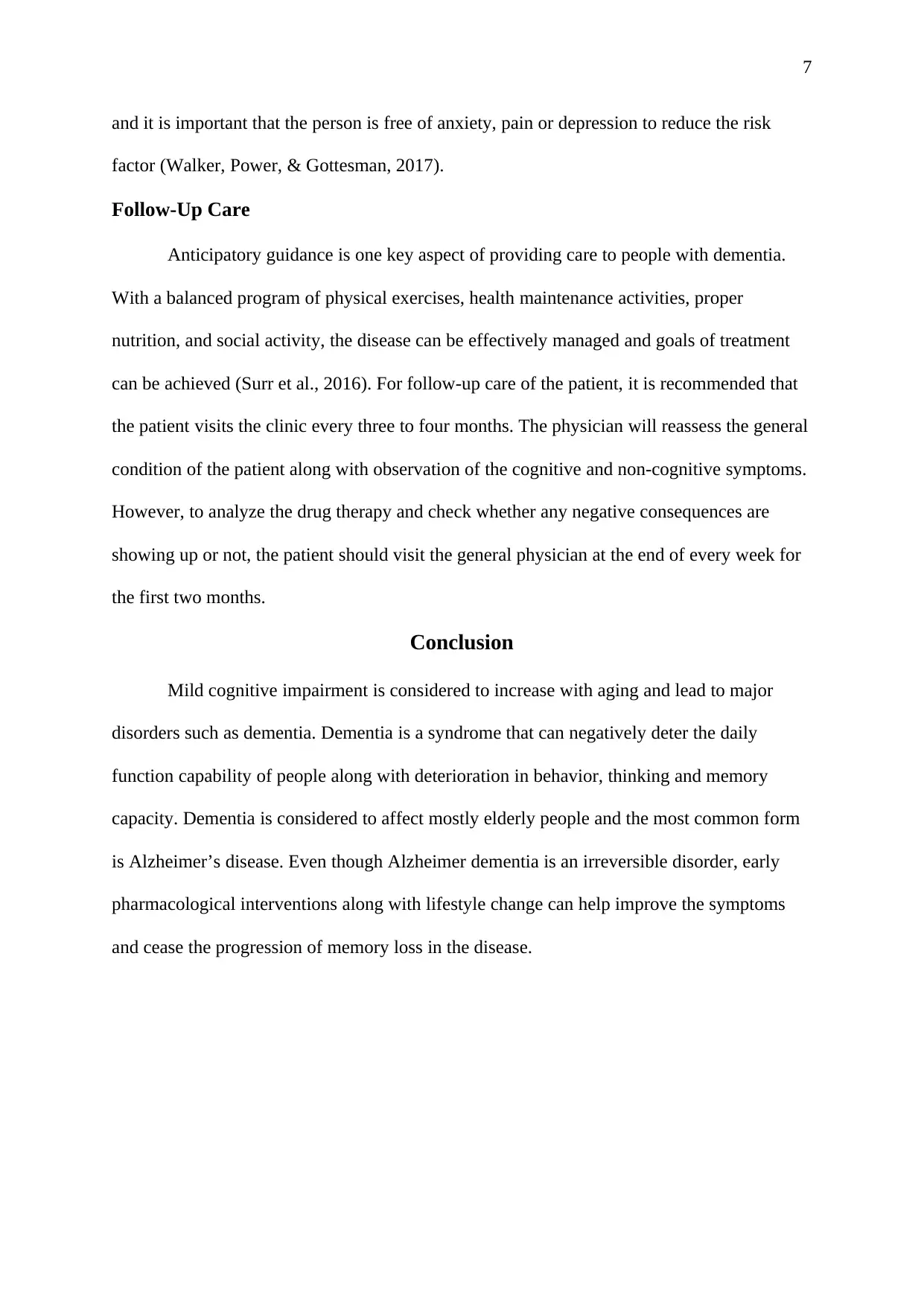
7
and it is important that the person is free of anxiety, pain or depression to reduce the risk
factor (Walker, Power, & Gottesman, 2017).
Follow-Up Care
Anticipatory guidance is one key aspect of providing care to people with dementia.
With a balanced program of physical exercises, health maintenance activities, proper
nutrition, and social activity, the disease can be effectively managed and goals of treatment
can be achieved (Surr et al., 2016). For follow-up care of the patient, it is recommended that
the patient visits the clinic every three to four months. The physician will reassess the general
condition of the patient along with observation of the cognitive and non-cognitive symptoms.
However, to analyze the drug therapy and check whether any negative consequences are
showing up or not, the patient should visit the general physician at the end of every week for
the first two months.
Conclusion
Mild cognitive impairment is considered to increase with aging and lead to major
disorders such as dementia. Dementia is a syndrome that can negatively deter the daily
function capability of people along with deterioration in behavior, thinking and memory
capacity. Dementia is considered to affect mostly elderly people and the most common form
is Alzheimer’s disease. Even though Alzheimer dementia is an irreversible disorder, early
pharmacological interventions along with lifestyle change can help improve the symptoms
and cease the progression of memory loss in the disease.
and it is important that the person is free of anxiety, pain or depression to reduce the risk
factor (Walker, Power, & Gottesman, 2017).
Follow-Up Care
Anticipatory guidance is one key aspect of providing care to people with dementia.
With a balanced program of physical exercises, health maintenance activities, proper
nutrition, and social activity, the disease can be effectively managed and goals of treatment
can be achieved (Surr et al., 2016). For follow-up care of the patient, it is recommended that
the patient visits the clinic every three to four months. The physician will reassess the general
condition of the patient along with observation of the cognitive and non-cognitive symptoms.
However, to analyze the drug therapy and check whether any negative consequences are
showing up or not, the patient should visit the general physician at the end of every week for
the first two months.
Conclusion
Mild cognitive impairment is considered to increase with aging and lead to major
disorders such as dementia. Dementia is a syndrome that can negatively deter the daily
function capability of people along with deterioration in behavior, thinking and memory
capacity. Dementia is considered to affect mostly elderly people and the most common form
is Alzheimer’s disease. Even though Alzheimer dementia is an irreversible disorder, early
pharmacological interventions along with lifestyle change can help improve the symptoms
and cease the progression of memory loss in the disease.
Paraphrase This Document
Need a fresh take? Get an instant paraphrase of this document with our AI Paraphraser
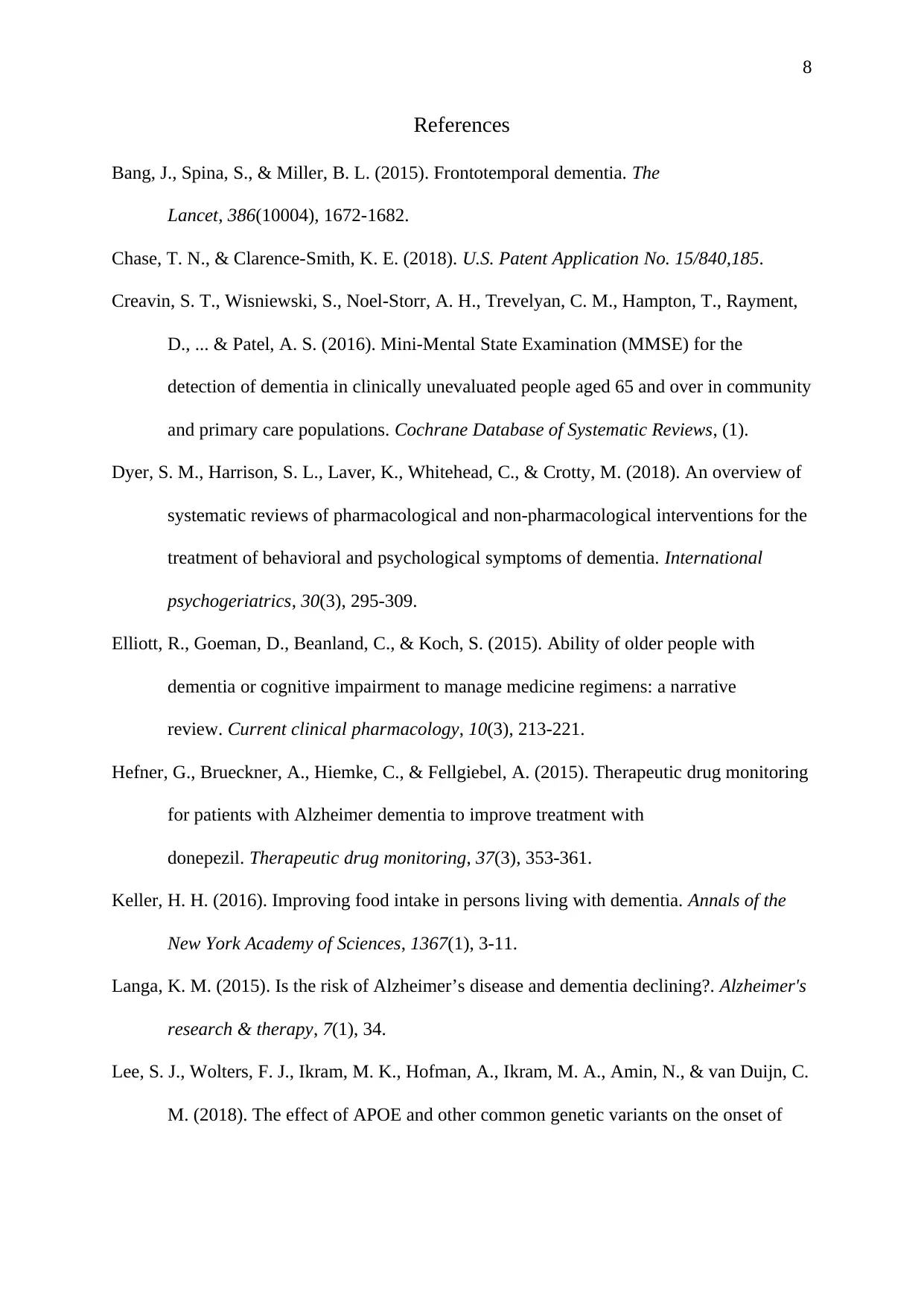
8
References
Bang, J., Spina, S., & Miller, B. L. (2015). Frontotemporal dementia. The
Lancet, 386(10004), 1672-1682.
Chase, T. N., & Clarence-Smith, K. E. (2018). U.S. Patent Application No. 15/840,185.
Creavin, S. T., Wisniewski, S., Noel‐Storr, A. H., Trevelyan, C. M., Hampton, T., Rayment,
D., ... & Patel, A. S. (2016). Mini‐Mental State Examination (MMSE) for the
detection of dementia in clinically unevaluated people aged 65 and over in community
and primary care populations. Cochrane Database of Systematic Reviews, (1).
Dyer, S. M., Harrison, S. L., Laver, K., Whitehead, C., & Crotty, M. (2018). An overview of
systematic reviews of pharmacological and non-pharmacological interventions for the
treatment of behavioral and psychological symptoms of dementia. International
psychogeriatrics, 30(3), 295-309.
Elliott, R., Goeman, D., Beanland, C., & Koch, S. (2015). Ability of older people with
dementia or cognitive impairment to manage medicine regimens: a narrative
review. Current clinical pharmacology, 10(3), 213-221.
Hefner, G., Brueckner, A., Hiemke, C., & Fellgiebel, A. (2015). Therapeutic drug monitoring
for patients with Alzheimer dementia to improve treatment with
donepezil. Therapeutic drug monitoring, 37(3), 353-361.
Keller, H. H. (2016). Improving food intake in persons living with dementia. Annals of the
New York Academy of Sciences, 1367(1), 3-11.
Langa, K. M. (2015). Is the risk of Alzheimer’s disease and dementia declining?. Alzheimer's
research & therapy, 7(1), 34.
Lee, S. J., Wolters, F. J., Ikram, M. K., Hofman, A., Ikram, M. A., Amin, N., & van Duijn, C.
M. (2018). The effect of APOE and other common genetic variants on the onset of
References
Bang, J., Spina, S., & Miller, B. L. (2015). Frontotemporal dementia. The
Lancet, 386(10004), 1672-1682.
Chase, T. N., & Clarence-Smith, K. E. (2018). U.S. Patent Application No. 15/840,185.
Creavin, S. T., Wisniewski, S., Noel‐Storr, A. H., Trevelyan, C. M., Hampton, T., Rayment,
D., ... & Patel, A. S. (2016). Mini‐Mental State Examination (MMSE) for the
detection of dementia in clinically unevaluated people aged 65 and over in community
and primary care populations. Cochrane Database of Systematic Reviews, (1).
Dyer, S. M., Harrison, S. L., Laver, K., Whitehead, C., & Crotty, M. (2018). An overview of
systematic reviews of pharmacological and non-pharmacological interventions for the
treatment of behavioral and psychological symptoms of dementia. International
psychogeriatrics, 30(3), 295-309.
Elliott, R., Goeman, D., Beanland, C., & Koch, S. (2015). Ability of older people with
dementia or cognitive impairment to manage medicine regimens: a narrative
review. Current clinical pharmacology, 10(3), 213-221.
Hefner, G., Brueckner, A., Hiemke, C., & Fellgiebel, A. (2015). Therapeutic drug monitoring
for patients with Alzheimer dementia to improve treatment with
donepezil. Therapeutic drug monitoring, 37(3), 353-361.
Keller, H. H. (2016). Improving food intake in persons living with dementia. Annals of the
New York Academy of Sciences, 1367(1), 3-11.
Langa, K. M. (2015). Is the risk of Alzheimer’s disease and dementia declining?. Alzheimer's
research & therapy, 7(1), 34.
Lee, S. J., Wolters, F. J., Ikram, M. K., Hofman, A., Ikram, M. A., Amin, N., & van Duijn, C.
M. (2018). The effect of APOE and other common genetic variants on the onset of
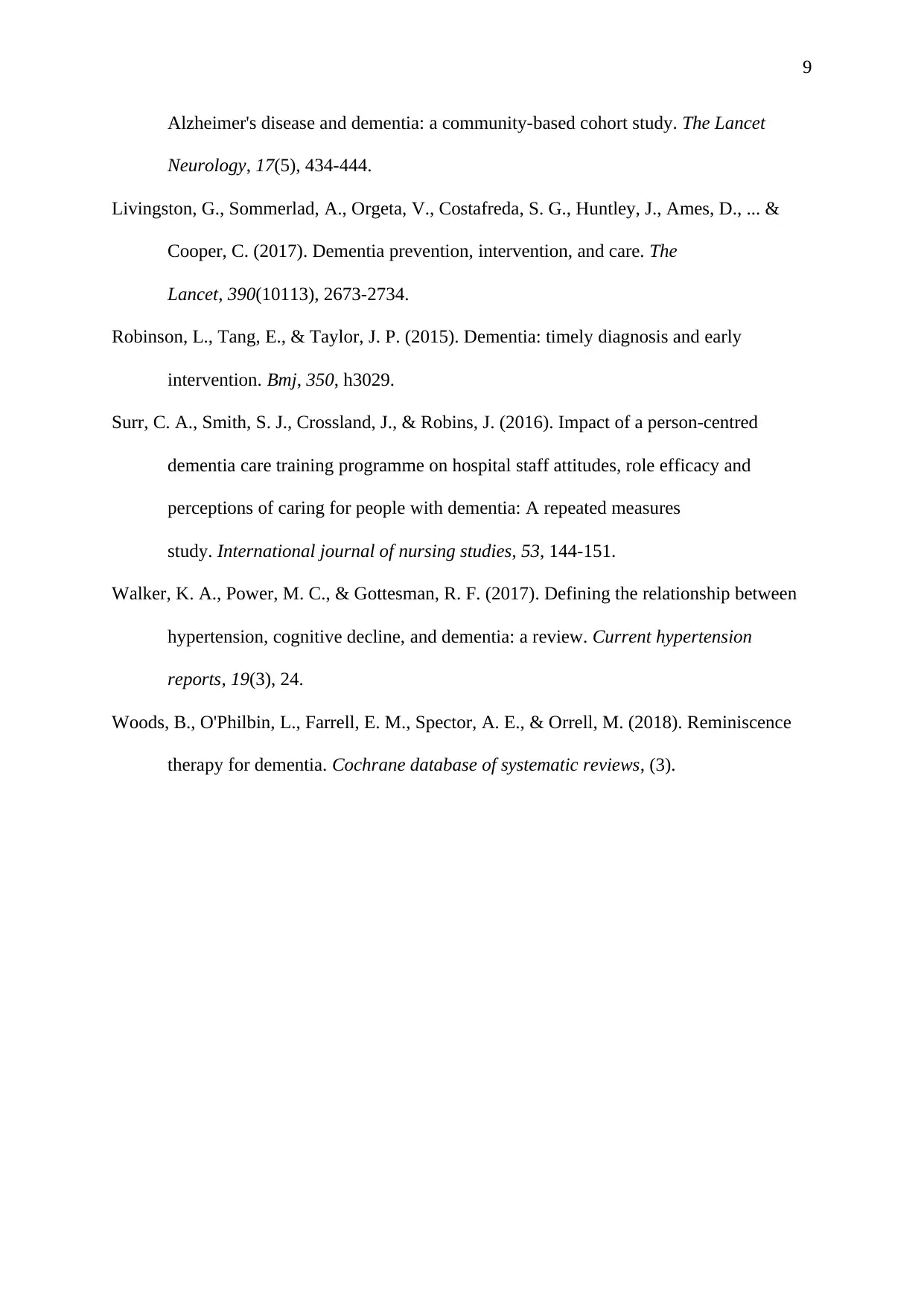
9
Alzheimer's disease and dementia: a community-based cohort study. The Lancet
Neurology, 17(5), 434-444.
Livingston, G., Sommerlad, A., Orgeta, V., Costafreda, S. G., Huntley, J., Ames, D., ... &
Cooper, C. (2017). Dementia prevention, intervention, and care. The
Lancet, 390(10113), 2673-2734.
Robinson, L., Tang, E., & Taylor, J. P. (2015). Dementia: timely diagnosis and early
intervention. Bmj, 350, h3029.
Surr, C. A., Smith, S. J., Crossland, J., & Robins, J. (2016). Impact of a person-centred
dementia care training programme on hospital staff attitudes, role efficacy and
perceptions of caring for people with dementia: A repeated measures
study. International journal of nursing studies, 53, 144-151.
Walker, K. A., Power, M. C., & Gottesman, R. F. (2017). Defining the relationship between
hypertension, cognitive decline, and dementia: a review. Current hypertension
reports, 19(3), 24.
Woods, B., O'Philbin, L., Farrell, E. M., Spector, A. E., & Orrell, M. (2018). Reminiscence
therapy for dementia. Cochrane database of systematic reviews, (3).
Alzheimer's disease and dementia: a community-based cohort study. The Lancet
Neurology, 17(5), 434-444.
Livingston, G., Sommerlad, A., Orgeta, V., Costafreda, S. G., Huntley, J., Ames, D., ... &
Cooper, C. (2017). Dementia prevention, intervention, and care. The
Lancet, 390(10113), 2673-2734.
Robinson, L., Tang, E., & Taylor, J. P. (2015). Dementia: timely diagnosis and early
intervention. Bmj, 350, h3029.
Surr, C. A., Smith, S. J., Crossland, J., & Robins, J. (2016). Impact of a person-centred
dementia care training programme on hospital staff attitudes, role efficacy and
perceptions of caring for people with dementia: A repeated measures
study. International journal of nursing studies, 53, 144-151.
Walker, K. A., Power, M. C., & Gottesman, R. F. (2017). Defining the relationship between
hypertension, cognitive decline, and dementia: a review. Current hypertension
reports, 19(3), 24.
Woods, B., O'Philbin, L., Farrell, E. M., Spector, A. E., & Orrell, M. (2018). Reminiscence
therapy for dementia. Cochrane database of systematic reviews, (3).
1 out of 9
Your All-in-One AI-Powered Toolkit for Academic Success.
+13062052269
info@desklib.com
Available 24*7 on WhatsApp / Email
![[object Object]](/_next/static/media/star-bottom.7253800d.svg)
Unlock your academic potential
© 2024 | Zucol Services PVT LTD | All rights reserved.





